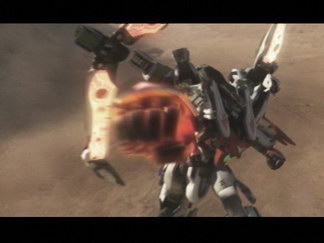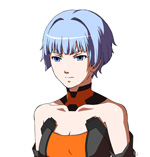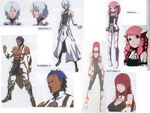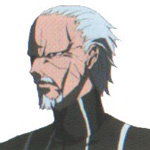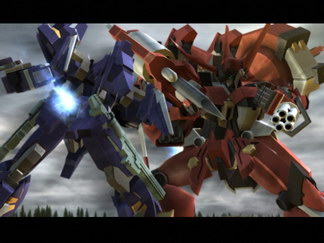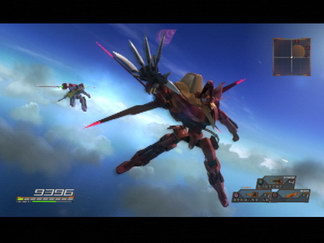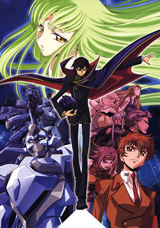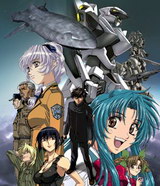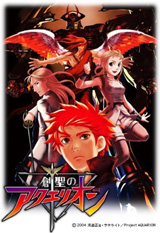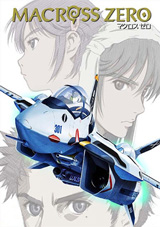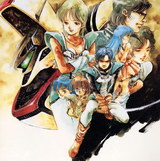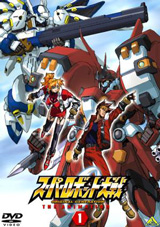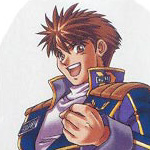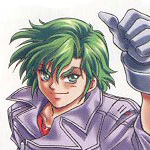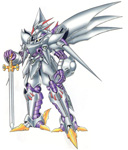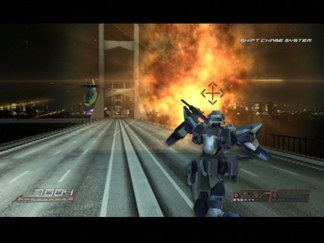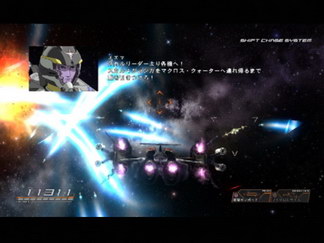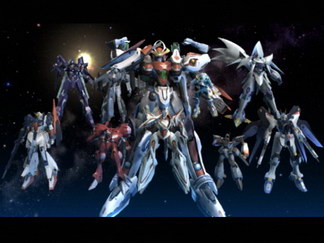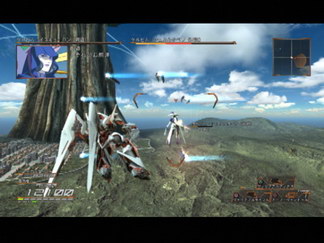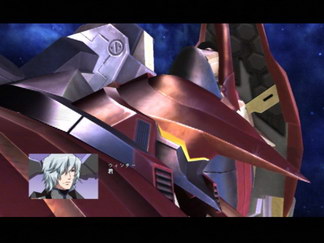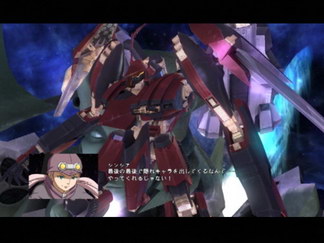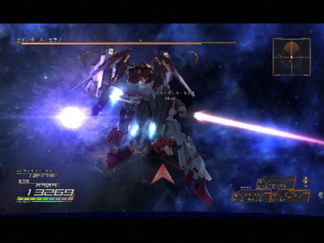
|
Page 1: |
Page 2: |
Page 3: |
Page 4: |
Page 5: |
|
|
|
|
Near the end of the PlayStation 3's fourth year, Banpresto decided to team up with From Software again and bring the ACE series out of retirement and into the HD era. Eight new series join the returning cast of Zeta Gundam, Char's Counterattack and King Gainer plus a few surprise crossovers. Taking place on the planet Aria, the story follows a female android named Autumn-4 who accidentally summons people from various universes due to yet another mishap with one of those pesky teleportation devices from the last game. The arrivals eventually band together to help Autumn-4 achieve her task, but their respective antagonists join forces with the opposition: A group of androids known as the Seasons. Despite the characters coming in from different points in their shows, only Macross Frontier gets any kind of plot development.
Autumn-4
Autumn-4 is an android created by the last remnants of Aria's civilization after the Seasons went rogue and started wiping them out. She commands the Ark-Alpha ship and the Alpha-Heart mech and is tasked with repopulating the planet by bringing its former inhabitants' store of genetic material out of its hiding place in a parallel dimension.
Alpha-Heart
This robot's minimal armaments belie its true strength. It can use tension to power up to three extra forms, each with different attacks.
The Seasons
A group of androids created by Dr. Shiki to protect Aria from alien invaders by utilizing a powerful planet-spanning barrier. They're led by Winter-1 and equipped with Sentimental Circuits to allow them to have feelings. At some point after their creation, their AI went rogue and started killing the inhabitants while imprisoning the rest with the very barrier that was supposed to protect them.
Quick Info:
|
Developer: |
|
|
Publisher: |
|
|
Genre: |
|
|
Themes: |
Another Century's Episode R
Another Century's Episode R
Another Century's Episode R
Code Geass: Lelouch of the Rebellion R2
Plot Summary:
In an alternate world where Britannia conquers Japan, exiled Britannian prince Lelouch vi Britannia gains the power to force anyone to obey his commands and combines it with his impressive tactical intellect to stage a rebellion. This puts him at odds with his Japanese childhood friend Suzaku Kururugi, who seeks to infiltrate Britannia from within and change things through peaceful means.
Mecha:
With the inclusion of knightmare frames in ACE, aura battlers have now been dethroned as the smallest mecha in the series. Knightmare frames employ ankle-mounted wheels and grappling hooks to achieve a high level of mobility and carry a variety of weapons both standard and exotic, like energy rifles, vibroblades and microwave radiation emitters. As of the show's second season, they've been fitted with Float Systems that allow them to fly.
Full Metal Panic!
Plot Summary:
In this alternate present, the Cold War never ended. A top secret Soviet experiment gone awry gave birth to select individuals known as the Whispered, who have innate knowledge of technology far ahead of its time. An anti-terrorist group called Mithril charges its top mercenary Sousuke Sagara with protecting one of these Whispered: A girl named Kaname Chidori.
Mecha:
ACER marks the first time the series has featured a show consisting entirely of grounded mecha. Arm slaves do not fly at all, but they have grappling hooks that allow them to scale large structures. They're armed with conventional weapons like shotguns and sniper rifles as well fancier gadgets like cloaking devices and explosives shaped like throwing daggers. The Arbalest is also equipped with a Lambda Driver which allows its pilot to channel his thoughts into destructive energy attacks.
Genesis of Aquarion
Plot Summary:
A great disaster devastated the Earth's surface and killed off most of mankind. It also awoke the Shadow Angels who quickly set about abducting the remaining population to harvest their life energy. Only the organization DEAVA and its legendary transforming robot Aquarion can stand up to them.
Mecha:
Aquarion is a combining mech very similar to Getter Robo in concept, which means three different sets of attacks at your disposal. However, whereas ACE3 treated Getter Robo as a single robot that can be launched as part of a squad, Aquarion can only be used by selecting its three jet components as your entire team. This means you can't have any wingman and
thus no access to support abilities, but in return each form of Aquarion has a separate set of hit points. You can also switch around some of its pilots to get different final attacks.
Macross Zero
Plot Summary:
A prequel set one year prior to the conflict between mankind and the Zentradi. It follows UN Spacy pilot Shin Kudo after he crash lands on Mayan Island, where he discovers a secret linking its inhabitants to the Protoculture.
Mecha:
The VF-0 performs much like its successors from the previous games. However, due to the changes in the game engine you can no longer fly in battroid mode and transforming into it mid-flight causes you to drop like a rock.
Macross Frontier
Plot Summary:
The newest Macross production follows the Macross Frontier fleet as it searches for a habitable planet. The fleet is soon attacked by a race of insectoid aliens called the Vajra, and former kabuki actor and pilot trainee Alto Saotome is drawn into the conflict.
Mecha:
The shiny new VF-25 Messiah fighters carry on the tradition of the line while adding new kinks. They retain the barrier shields introduced to the line by the YF prototypes, as well as two different sets of armor packs. They also pack knives for close range combat. You get a variant equipped with a sniper rifle and one specializing in electronic warefare that controls three unmanned drones. Unfortunately, the Messaihs can't fire their trademark missiles in battroid mode without an armor pack and still can't fly in that mode either.
Mobile Suit Crossbone Gundam
Plot Summary:
Ten years after the Cosmo Babylon Wars depicted in the Gundam F91 movie, Seabook Arno and Cecily Fairchild reform the Crossbone Vanguard under new aliases and oppose the Jupiter Empire under the guise of space pirates. Young transfer student Tobia Arronax is swept into the conflict when his fate intertwines with a mysterious girl named Bernadette.
Mecha:
Hajime Katoki's themed designs can sometimes be hit or miss, but when he nails it, he nails it! The awesome Crossbone Gundams are mostly close-to-mid range mecha with a variety of melee attacks and a standard beam weapon. The X-3 also carries the Muramasa Blaster, which is a Swiss army knife of death consisting of a beam rifle and a saber with fifteen beam blades!
Mobile Suit Gundam Seed Destiny
Plot Summary:
Two Years after the end of the Bloody Valentine War between the Naturals and the Coordinators, tensions once again rise between both sides when an Earth Alliance special forces unit steals some of ZAFT's newest Gundam mobile suits (in a reversal of the situation from Gundam Seed. How precious). ZAFT's new battleship the Minerva is tasked with retrieving the stolen suits with the help of the remaining Gundam piloted by Shinn Asuka, an Orb immigrant embittered by the loss of his family during the last war.
Mecha:
Like its predecessor's inclusion in ACE3, Destiny's line-up consists of three end show Gundams. The Strike Freedom and Infinite Justice are mostly identical to their older counterparts while the Destiny is a jack of all trades suitable for both long and short range combat.
Super Dimension Century Orguss
Plot Summary:
In the far future, two major superpowers go to war over control of a space elevator. In desperation, one of them sends a squad of variable fighters with a space/time oscillation bomb to destroy it. Due to improper calibration however, the explosion merges several different worlds and flings fighter pilot Kei Katsuragi into it. With the humanoid Emaan as his only allies, Kei must evade the human Chiram military and make his way back to the space elevator where it all began.
Mecha:
Being a distant relative of the valkyries from Macross, the Orguss shares most of their characteristics but has a few twists of its own. Mainly swapping out the machine gun for a missile launcher and having an extra tank mode. Unlike the valkyrie's battroid mode however in this game the Orguss' orgaroid mode can hover in the air.
Super Robot Wars: Original Generations
Plot Summary:
Original Generations is a universe in which Banpresto's vast roster of original characters culled from over ten years of Super Robot Wars games coexist together.
Kyosuke Nanbu
Kyosuke is the no-nonsense commander of the ATX team. Calm and decisive, but likes to gamble against low odds.
Alt Eisen Riese
A heavily modified and upgraded Gespenst geared for close to mid range combat. Its signature armaments include an arm mounted pilebunker and a titanium ball bearings launcher. It's name roughly translates to "scrap iron giant" from German.
Ryusei Date
A huge mecha fan who was scouted by the military due to his talents and latent psychic abilities. Ryuusei has a tendency to yell out overly dramatic attack names during battle.
ART-1
An experimental machine based on Ryuusei's R-1. It packs a pair of pistols, a rifle, arm mounted chainsaws and the ability to transform into a flight mode.
Masaki Andou
The first of Banpresto's original characters. A hot blooded youth who was summoned to the underground world of La Gias to be chosen as a pilot for the mystical Elemental Lord robots. He has a tendency to get lost easily due to lacking a sense of direction. Masaki also travels with a pair of talking cat familiars called Shiro and Kuro.
Whereas Banpresto, now absorbed into Namco Bandai, was content to let From Software handle everything for the last three games, they decided to get more hands on with ACER, resulting in quite a few odd design choices. The first major change involved stripping down the boosting system and reducing it to little more than a method to travel quickly between locations. You can no longer fire your weapons when boosting and repeatedly boost dashing between shots becomes necessary to your survival. Unfortunately this is further compounded by forcing you to press the X button to dodge rather than just double tapping the direction, and the amount of times you can boost dodge is now determined by your pilot's stats instead of the boost gauge. Additionally, a lot of mechs can no longer hover in place and must be constantly elevated manually, which is pretty silly considering the game still heavily revolves around fighting in the air.
Another oddity veterans and newcomers alike will notice is that on some mechs the main weapon cannot be fired repeatedly just by pressing the shoot button. Instead, there's a very asinine game mechanic that involves tapping the button to very specific rhythm in order to get off a constant volley of shots, and this rhythm is different for each mech and often very difficult to consistently pull off in the heat of battle. Melee attacks have also been changed. Instead of relying on alternate button inputs to get different combos, you achieve them by preceding the button press with directional inputs or a half second delay. This results in combo animations so slow that either your target will escape or you'll get pelted by the surrounding enemies before you can finish. This one-two punch of frustration knocks us into the game's most controversial addition: The tension gauge.
In the previous games, all of your mech's attacks were readily available from the start and were only restricted by their reload times. ACER ditches that system completely in favor of the new tension gauge. Somewhat similar to the morale system from the Super Robot Wars games, the gauge is what allows you to unlock your mech's more potent attacks during the mission. Generally the gauge fills by attacking and destroying enemies, allowing you to stock several bars of tension to spend on attacks. Since your mech's abilities are no longer directly available on the HUD, you have to cycle between them in groups of three which can be partially customized. Unfortunately, whether you land the attack or not the tension will be used up and you'll have build it up again using your default gun and melee weapon, which along with your abysmal tension gain rate at the game's onset makes using certain mechs an incredible chore.
Other new features include Chase Mode, which consists of short on-rail shooter sequences used in some the introductory stages. Pilots now have upgradable stats that, among other things, allow them to unlock more melee combos and two new attacks for each mech: The Rush Attack and the Limit Break. Rush Attacks are charged and are either a rapid stream of shots targeting multiple enemies in succession or a single strong attack, while Limit Breaks cause your mech to glow red and initiate a short invincible charge at the target, which upon hitting will cause your mech to mercilessly wail on them at point blank range. It's the only attack in the game that won't waste tension if it doesn't connect.
Combination attacks and passive support abilities are gone, and in their place are support attacks. Every mech has one of several types, ranging from offensive attacks to defensive spells like healing, tension boosts and jamming against enemy missiles. They cost health to use and depending on your pilot and mech stats can only be used two or three times at most before leaving you or your wingmen near death.
Missile attacks which have been prevalent since the second game are still as effective as ever, but now you're limited to targeting only what's inside a rectangular reticle as opposed to the entire screen. The shield function introduced in the ACE3 has now been expanded. Putting up your shield holds you in place and negates damage from most enemy attacks. Physical shields break after a set amount of damage while energy shields drain your tension.
ACER's opening song is the bombastic "The:Birth", which comes courtesy of Acid Black Cherry. To the dismay of fans however, the BGMs of all the included series with the exception of Macross Frontier's have gone back to being instrumental only. This point is made moot however by ACER's incredibly robust custom soundtrack feature, which allows you to set the tune of your choice to the individual segments of each mission.
At the start of the game, you're asked to choose a series from the game's line-up. This determines the starting stages where you follow the protagonists from the point where they get transported to Aria until they meet the rest of the cast. Aside from that and a single branching path, the rest of the game's progression is linear. However you can go back to replay previous missions at anytime to grind for upgrade points. Finishing the game nets you a unique ending for your chosen series and unlocks a secret mech for use in your next playthrough. With the secret objectives done away with, unlocking everything means having to finish the game eleven times, though given the game's short length (18-19 missions on any path) it's not too much of a drag. Playing through the game multiple times also gradually unlocks Extra Missions 1 through 10. Unlike the previous games, these missions are actually varied and fun since they revolve around overcoming challenges with a specific mech. Two of them even let you play as unique mech not available anywhere else in the game. Though there's not much to say about blasting Vajra with the sluggish Macross Quarter, the other secret unit is so cool it deserves its own section which we'll get to later.
On the whole the game is a mish-mash of design choices that favor certain mechs at the cost of the playability of others. Picking a mech to play with boils down not to which is your favorite but to which isn't crippled by the game engine and only after sinking substantial amounts of points into upgrades does the game become less tedious overall. While adding the arm slaves from Full Metal Panic was an interesting experiment, the game makes little compensation for the fact that 95% percent of the enemies in this game can simply fly out of their reach and that their grappling hooks were sloppily implemented afterthoughts. Not to mention that they're entirely unavailable in missions taking place in the sky. In fact even after finishing the game several units from other series are still locked out of certain missions for pointless plot reasons. You can't even play with the armored valkyries; which have once again been restricted to space missions; in the practice stage because there's no space variation of it like the previous games. There's also partial loss of camera control due to mech transformations hogging the right analogue stick, forcing you to hold a button before you can rotate the view around you.
Although the playable roster of mechs has shrunk noticeably compared to ACE3, it's the secret unlockables that took a hit in quality. There are several awesome secret mechs, but the other half are literally recolored or downgraded variants of existing ones and practically none of the bosses in the game are playable.
The inclusion of Macross Frontier, which at the time of ACER's release was still a hot property in Japan, and the bizarre favoritism given to its handling also raises suspicion of executive meddling by its license owners Big West and Studio Nue. To elaborate: Frontier is the only series in the game that gets its major plot points covered, as well as the only series to have its vocal songs included in the game's soundtrack. The latter point gives us a peculiar situation during certain missions where anytime a cutscene includes a song from Frontier it's completely unskippable. Depending on who you ask this was either mandated by the licensing agreement or a technical issue related to synching the song. Either way this leads to what is easily the game's biggest low point: The final Frontier mission which plays out the big battle from the last episode of the TV series is literally a fifteen minute unskippable cutscene interspersed by a few brief segments of Chase Mode. In a bizarre ploy to nearly force as much exposure of this horrible stage as possible, completionist players are required to "play" it with every unit in the game to unlock a trophy.
Arguably the most telltale sign of Banpresto's heavy involvement with ACER is the way the story is presented. The dialogue scenes between missions are lifted straight out of a Super Robot Wars game, with talking heads and loads of text, character interactions and in-jokes. While the mid-mission cutscenes ditch the cel-shaded character art in favor of tiny character portraits that belt out recorded lines without any kind of lip-synching. It's incredibly jarring how little Banpresto understands the difference between working on a strategy RPG and an action game, illustrated rather profoundly in the game's final mission. ACER's finale; a frantic gauntlet of five consecutive bosses (six if you meet the requirements for the hidden one); has a combined cutscene runtime of over 50 minutes! That's nearly an hour spent watching mechs hover in the air from different angles doing nothing while their pilots endlessly prattle on about the machinations of the plot, their love lives and why toast always lands butter side down.
ACER is a neutered dog. It ditches nearly everything that made the last three games so easy to pick up and enjoyable in favor of adding artificial difficulty and wasting enough resources on a bloated plot to power a couple of Playstation 1 RPGs.
Surprise Attacked: Nineball Seraph
Armored Core fans who managed to cover their eyes and ears through the onslaught of spoilers on the internet were in for a nasty surprise upon their third playthrough of the game. Just before facing you himself, Winter-1 throws you a curveball in the form of Nineball Seraph. Nineball is a recurring nemesis in the Armored Core series and his Seraph form was the final boss of Armored Core: Master of Arena. To further sweeten the deal, From Software for the first time ever allows you to play as this monstrosity in the aptly numbered Extra Mission 9, where you can make full use of his superior abilities and firepower to destroy a thousand enemy units.
Another Century's Episode R
|
Page 1: |
Page 2: |
Page 3: |
Page 4: |
Page 5: |
|
|
|
|

